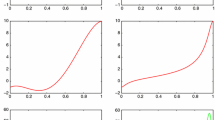Abstract
Lens-shaped surfaces (with vertices of valence 2) arise for example in automatic quad-remeshing. Applying standard Catmull–Clark subdivision rules to a vertex of valence 2, however, does not yield a C 1 surface in the limit. When correcting this flaw by adjusting the vertex rule, we discover a variant whose characteristic ring is z → z 2. Since this conformal ring is of degree bi-2 rather than bi-3, it allows constructing a subdivision algorithm that works directly on the control net and generates C 2 limit surfaces of degree bi-4 for lens-shaped surfaces. To further improve shape, a number of re-meshing and re-construction options are discussed indicating that a careful approach pays off. Finally, we point out the analogy between characteristic configurations and the conformal maps z 4/n, cos z and e z.
Similar content being viewed by others
References
Catmull E, Clark J (1978) Recursively generated B-spline surfaces on arbitrary topological meshes. Comput Aided Des 10: 350–355
Dong S, Kircher S, Garland M (2005) Harmonic functions for quadrilateral remeshing of arbitrary manifolds. Comput Aided Geom Des 22(5): 392–423
Grandine T (2008) Boeing Corp., personal communication
Kälberer F, Nieser M, Polthier K (2007) Quadcover—surface parameterization using branched coverings. Comput Graph Forum 26(3): 375–384
Karciauskas K (2001) Biangle surface patches. Mathematical methods for curves and surfaces Oslo 2000. In: Lyche T, Schumaker LL (eds) Vanderbilt University Press, pp 233–242
Karčiauskas K, Peters J (2007) Concentric tesselation maps and curvature continuous guided surfaces. Comput Aided Geom Des 24(2): 99–111
Karčiauskas K, Peters J (2007) Surfaces with polar structure. Computing 79: 309–315
Karciauskas K, Krasauskas R (1998) Rational biangle surface patches. In: Skala V (ed) WSCG’98 Conference Proceedings
Peters J, Reif U (2008) Subdivision surfaces. Geometry and computing, vol 3. Springer, New York
Reif U (1996) A degree estimate for subdivision surfaces of higher regularity. Proc Am Math Soc 124(7): 2167–2174
Sabin M (1998) Two-sided patches suitable for inclusion in B-spline surfaces. Mathematical methods for curves and surfaces II. In: Lyche T, Dahlen M, Schumaker LL (eds) Vanderbilt University Press, pp 409–416
Tong Y, Alliez P, Cohen-Steiner D, Desbrun M (2006) Designing quadrangulations with discrete harmonic forms. In: Sheffer A, Polthier K (eds) Eurographics symposium on geometry processing (Cagliari, Sardinia, Italy), Eurographics Association, pp 201–210
Zorin D, Schröder P (2001) A unified framework for primal/dual quadrilateral subdivision schemes. Comput Aided Geom Des 18(5): 429–454
Author information
Authors and Affiliations
Corresponding author
Additional information
Communicated by C.H. Cap.
Rights and permissions
About this article
Cite this article
Karčiauskas, K., Peters, J. Lens-shaped surfaces and C 2 subdivision. Computing 86, 171–183 (2009). https://doi.org/10.1007/s00607-009-0060-9
Received:
Accepted:
Published:
Issue Date:
DOI: https://doi.org/10.1007/s00607-009-0060-9




